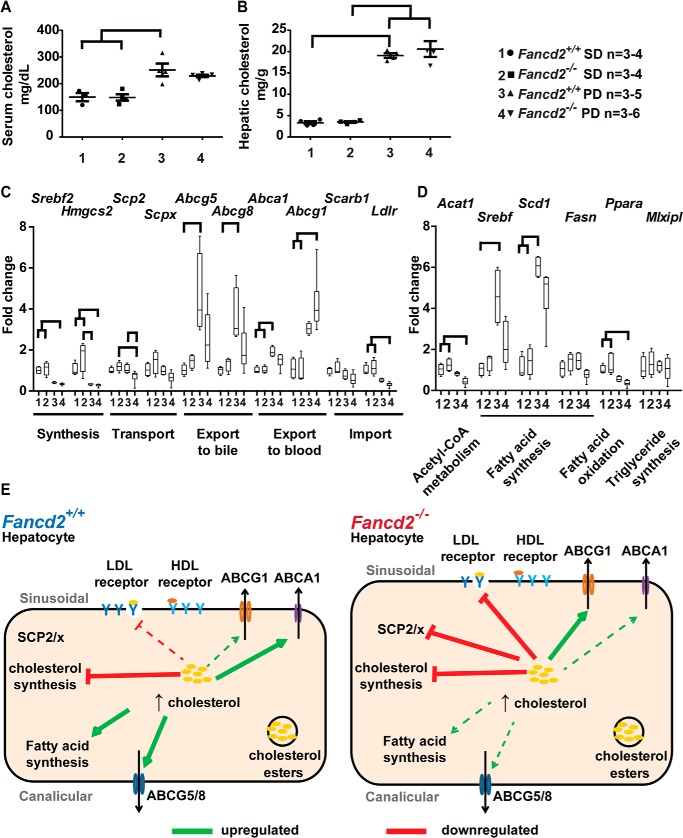Figure 5.
Male Fancd2−/− mice had differential cholesterol and lipid metabolism gene expression upon Paigen diet feeding. After feeding PD or SD for 50–55 days, livers were collected for RNA extraction and used for quantitative PCR. All comparisons are expressed as fold change relative to the WT SD group. Total serum (A) and hepatic (B) cholesterol increased on Paigen diet feeding in both genotypes in male mice (p < 0.05 for indicated comparisons). C, expression of genes encoding proteins involved in cholesterol metabolism and transport. Both genotypes decreased expression of Srebf2 (Srebp2), encoding the major transcription factor regulating cholesterol synthesis and Hmgcs2, encoding a cholesterol synthesis enzyme, upon Paigen diet feeding. Fancd2−/− mice had decreased expression of the cholesterol transporters encoded by Scp2/x upon Paigen diet feeding and failed to up-regulate expression of the cholesterol exporters encoded by Abcg5/8 and Abca1 upon Paigen diet feeding, as was observed in WT Paigen diet–fed mice. Fancd2−/− but not WT mice had a significantly increased expression of the cholesterol exporter Abcg1 upon Paigen diet feeding. LDL receptor (Ldlr) expression decreased in both genotypes upon Paigen diet feeding but decreased significantly only in Fancd2−/− mice. D, expression of genes involved in acetyl-CoA, fatty acid, and triglyceride metabolism. Fancd2−/− mice had decreased expression of Acat1, which converts two acetyl-CoAs to acetoacetyl-CoA as an early step in lipid, ketone, and amino acid synthesis, whereas Paigen diet feeding did not significantly impact expression of Acat1 in WT mice. Upon Paigen diet feeding, WT but not Fancd2−/− mice increased expression of Srebf1 (Srebp1c), the major transcription factor regulating fatty acid synthesis. A trend toward lower expression of Fasn (fatty-acid synthase), a transcriptional target of SREPB1c, was seen in Fancd2−/− mice fed the Paigen diet. Ppara, a gene regulating fatty acid oxidation, decreased upon Paigen diet feeding in both genotypes, although the decrease was significant only for Fancd2−/− mice fed the Paigen diet. E, summary of differential expression of genes encoding proteins involved in cholesterol and lipid metabolism by FANCD2 status upon Paigen diet feeding in male WT (left) and Fancd2−/− mice (right). Solid lines indicate statistically significant up/down-regulation. Dashed lines indicate nonsignificant trends. Error bars in dot plots represent S.E. Box and whisker plots show 25th to 75th percentiles (box) and minimum and maximum (whiskers), with the median indicated by the horizontal bar. p < 0.05 for all pairwise comparisons indicated.

